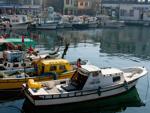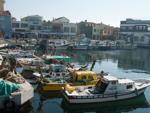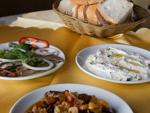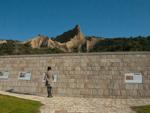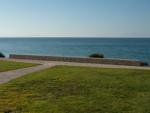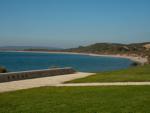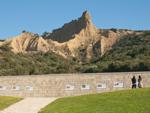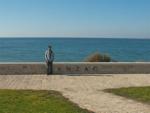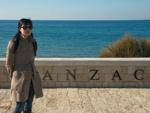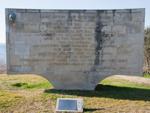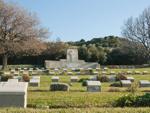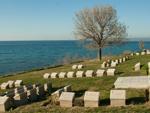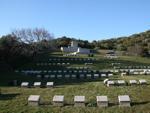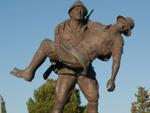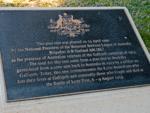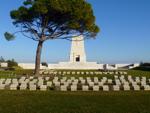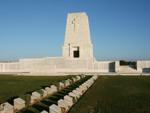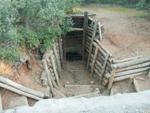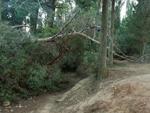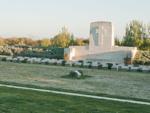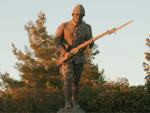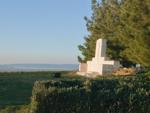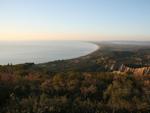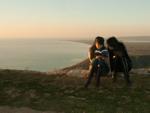The Gallipoli Campaign was the first major battle undertaken by the Australian and New Zealand Army Corps (ANZAC) during the First World War. We had all learnt in school how important this event is to Australian history and the Australian identity. A trip to Turkey would not be complete without Gallipoli.
We left early from Istanbul starting the five hour drive to Gallipoli. We stopped for lunch at Ilhan Restaurant in Gelibolu a seaside town on the east coast of the Gallipoli peninsula. We sampled some mezze and grilled sea bass, which the waiter even kindly de-boned for us.
thydzikgooglemap(http://sonyaandtravis.com/maps/turkey-2011-istanbul-to-north-beach-gallipoli.xml)
I planned the Anzac Walk (or drive) for us which was a self guided tour of the sites recommended and detailed by the Australian Government. We arrived at the starting location in the afternoon and having arrived off season it was nice having the whole place to ourselves.
thydzikgooglemap(http://sonyaandtravis.com/maps/turkey-2011-anzac-walk.xml,s,13)
Download the ANZAC Walk in GPX format for your GPS.
1. North Beach – Anzac Commemorative Site
The Anzac Walk begins at the Anzac Commemorative Site on the north beach. Upon reaching the cove it was hard not to notice how serene and beautiful the cove is. Walking to towards the sea we saw the letters ANZAC on one of the commemorative walls. Facing the rugged landscape was a second commemorative wall detailing the Gallipoli Campaign timeline. It was a sombre story.
2. Ari Burnu Cemetery
Driving south we reached the first cemetery. Ari Burnu is named from the Cape at the North end of Anzac Cove. Whilst the majority of graves were ANZACs, three Indian soldiers were also buried there.
3. Anzac Cove and Turkish Dedication
The Anzac Cove (Anzak Coyu in Turkish) marks the Anzac Cove named in 1985. The Anzac Cove has a touching Turkish Dedication with words from Atatürk (father of the Turks).
“Heroes who shed their blood and lost their lives! You are now lying in the soil of a friendly country. Therefore rest in peace. There is no difference between the Johnnies and Mehmets to us where they lie side by side here in this country of ours. You, the mothers, who sent their sons from far away countries wipe away your tears; your sons are now lying in our bosom and are in peace. After having lost their lives on this land they have become our sons as well.”
4. Hell Spit Cemetery
Further south of Anzac Cove is Hell Split Cemetery, the last cemetery next to the sea.
5. Shrapnel Valley Cemetery
Shrapnel Valley was the main route for ANZAC troops and supplies between the beach and the front-line.
6. Lone Pine Cemetery and Memorial
Lone Pine Cemetery named after a single Turkish pine tree on the plateau was the location of battles between Australian and Turkish forces. Today the plateau is a cemetery and memorial with magnificent views.
7. Johnston’s Jolly Cemetery
Johnston’s Jolly named after the 2nd Australian Division Artillery AIF, commanded by Brigadier General G. J. Johnston.
To the right and opposite of the cemetery are original preserved trenches.
8. Courtney’s and Steel’s Post Cemetery
Courtney’s Post was named after Lieutenant Colonel Richard Courtney of the 14th Australian Infantry Battalion and Steel’s Post named after Major Thomas Steel also of the 14th Australian Infantry Battalion.
9. Quinn’s Post Cemetery
Quinn Post was named after Major Hugh Quinn of the 15th Battalion of Charters Towers, Queensland.
10. Turkish Memorial
The Turkish Memorial was unfortunately under renovation at the time.
11. The Nek Cemetery
The Nek Cemetery is at the location of the Battle of the Nek, a battle on a narrow stretch of ridge. The cemetery offered amazing views of Anzac Cover.
The Nek Cemetery concluded the walking tour.
We drove to Eceabat on the shore of the Gallipoli peninsula and rode a ferry to Çanakkale on the Asian side of Turkey. Çanakkale is the nearest town to the famous Troy which we planned to explore the next day.
thydzikgooglemap(http://sonyaandtravis.com/maps/turkey-2011-north-beach-gallipoli-to-canakkale.xml)




































































































